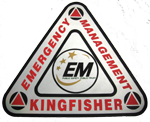 |
|||
Flood Safety
(Requires Adobe Reader. Get Adobe Reader here.)
Flood Safety in Oklahoma
Flash floods are the number one cause for weather-related deaths in the United States an average of 100 people a year lose their lives in floods nationwide, with flood damage in backspace and damage averaging more than $2 billion.
In Oklahoma more than $97 million in flood insurance payments were made from 1978 to 2002. Numerous Oklahomans have been killed by floods since 1995.
The following tips will help keep you safe during a flood:
- Stay informed. Turn on a battery-operated radio or television to get the latest emergency information. Continue listening to radio for news about what to do where to go and places to avoid.
- If advised to evacuate, do so immediately. Evacuation is much safer before floodwaters become too deep for ordinary vehicles drive through. Follow recommended evacuation routes.
- Avoid walking through flood water. Water only 6 inches deep can sweep you off your feet if it is moving swiftly.
- Do not drive into a flooded street. Cars can be swept away by 2 feet of moving water or there may be unseen damage to the road. If you come to a flooded area turn around and go another way. Most flood-related deaths are caused by people driving through water.
- Watch out for fire hazards. Be aware of broken or leaking gas lines, flooded electrical circuits, electrical appliances and flammable materials coming from upstream.
Plan Ahead for Floods:
- Find out if you live in a flood-prone area. Ask whether your property is above or below the flood stage water level and learn about the history of flooding for your region.
- Plan and practice an evacuation route. Individuals living in flash flood areas should have several alternate routes. Have disaster supplies on hand for easy access.
- Learn about the National Flood Insurance Program. Ask your insurance agent about flood insurance. Homeowners’ policies do
not cover food damage.
After the Flood
- Protect yourself and your family from stress, fatigue and health hazards that follow a flood.
- Dry out your home. Floodwaters damage materials, leaf mud, silt and unknown contaminants, and promote the growth of mold and mildew.
- Restore the utilities. Cleanup will be much easier if you have heat, electricity, sanitary water and sewage disposal.
- Clean up. The walls, floors, closets, shelves, contents and any other flooded parts of your home should be thoroughly washed and disinfected.
- Rebuild and flood proof. Take time to rebuild correctly and make improvements that will protect your building from damage by the next flood.
- Prepare for the next flood. Protect yourself from the next flood with flood insurance, a flooded response plan in community flood protection programs.
For more information visit the Oklahoma Floodplain Managers Association web site at www.okflood.org.